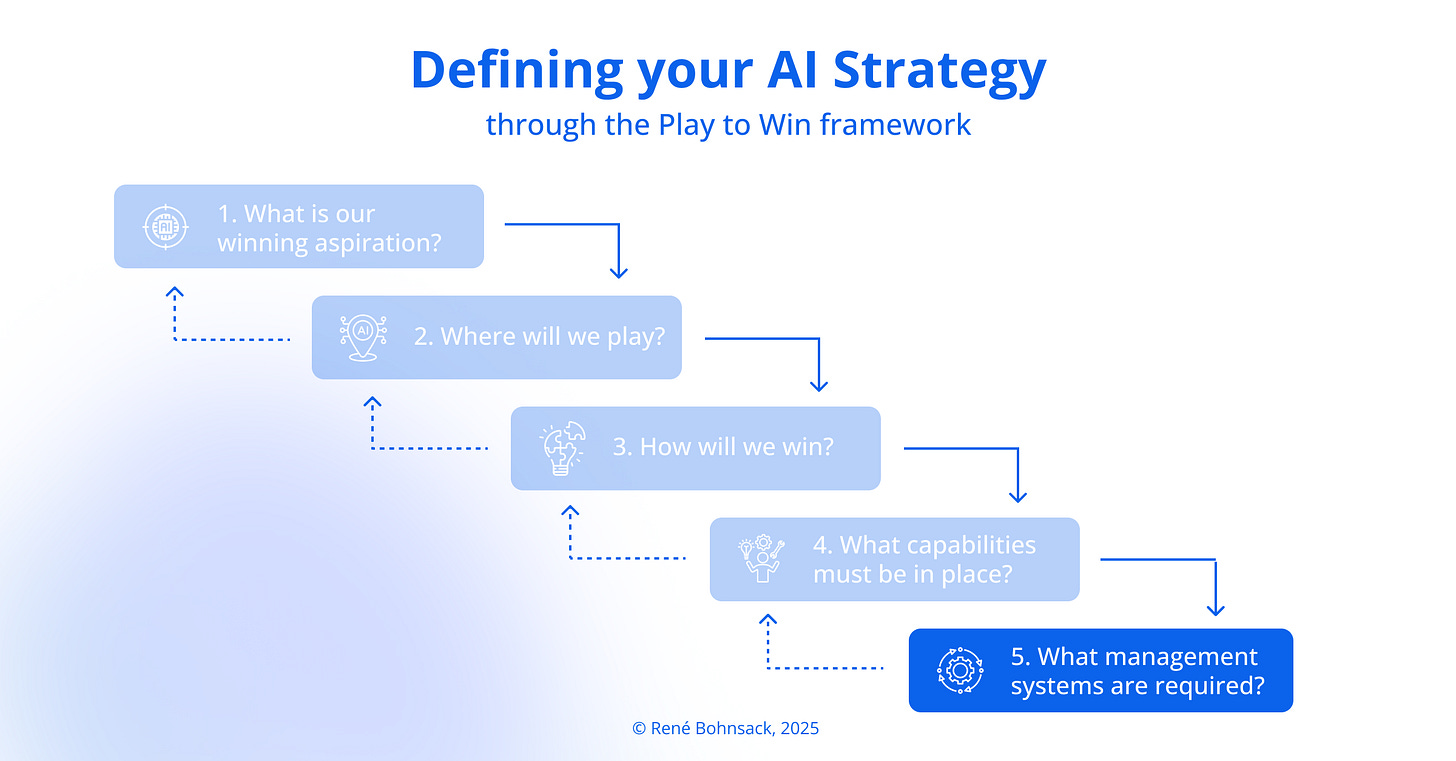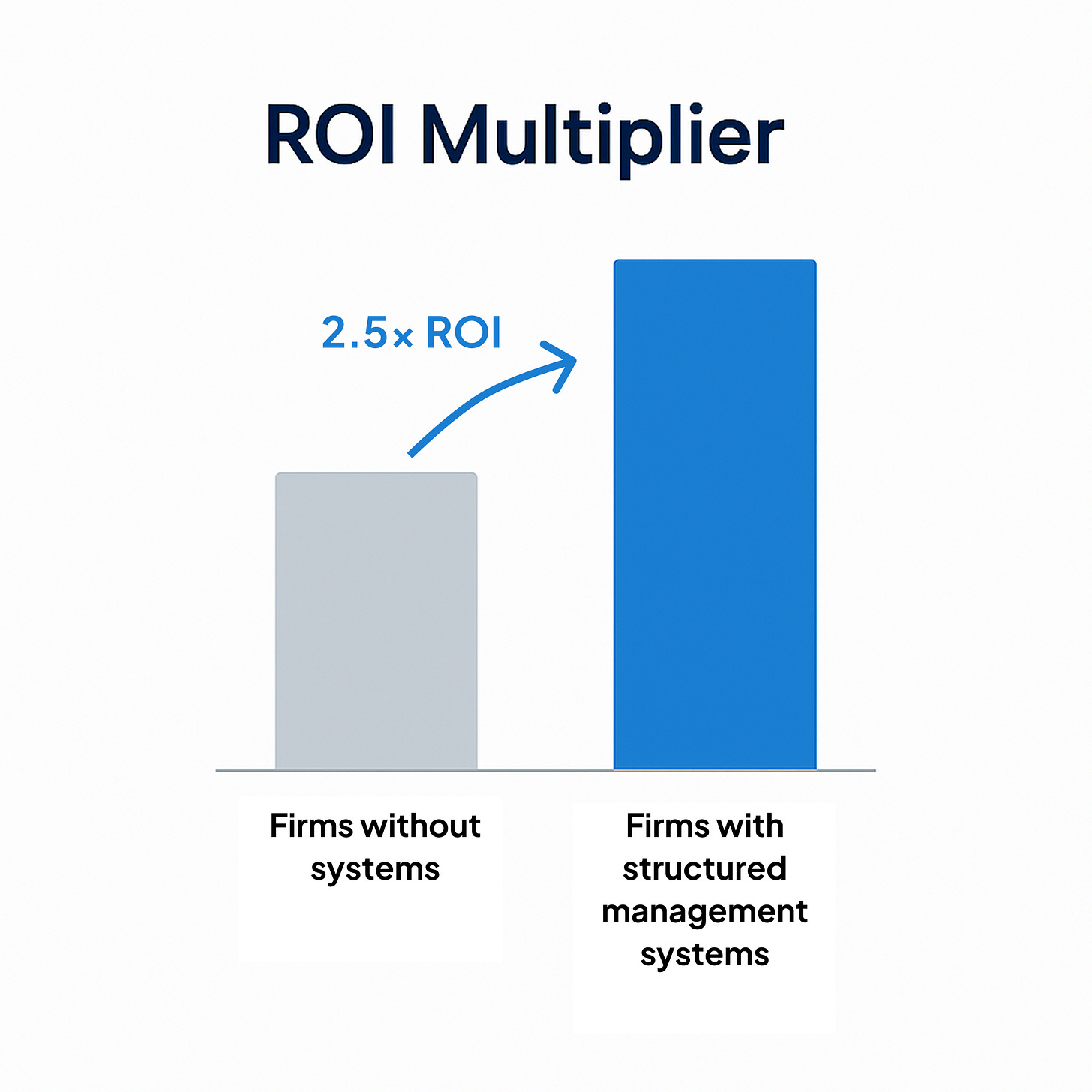Embedding AI Strategy - The Role of Management Systems
TL;DR
The fifth and final stage of Play to Win asks: What management systems are required?
Management systems make strategy stick: they turn choices into habits, metrics, and culture.
Without governance, incentives, and accountability, AI strategies drift back into scattered pilots.
Data shows: 70% of AI pilots fail to deliver ROI (BCG), and only 1% of firms report mature rollouts (McKinsey 2025).
Employees trust their employers (71%) more than governments or tech firms to deploy AI safely (McKinsey), making internal governance critical.
Companies with structured AI systems see 2.5x higher ROI (Google ROI of AI 2025).
The AI Roadmap Canvas helps leaders translate strategy into action across governance, technology, talent, and operations.
Case study: Dubai Airports shows how embedding management systems turns pilots into transformation.
Looking Back: The Four Stages That Brought Us Here
Over the past articles, we’ve walked through the first four stages of Play to Win applied to AI strategy:
Winning Aspiration - Defining the North Star that gives AI its purpose and coherence.
Where to Play – Choosing the arenas where AI will create the most impact (and where not to).
How to Win – Pinpointing the mechanism of advantage that differentiates your AI strategy.
Capabilities – Building the muscles: data, infrastructure, skills, and culture that turn ambition into execution.
Each step matters. But without the right management systems, even the best strategy will unravel.
Why Management Systems Matter
Strategy doesn’t fail in the boardroom. It fails in the everyday. It fails when incentives reward the wrong behaviors, when KPIs don’t reflect strategic priorities, when governance is absent, and when decisions are made in silos.
The data confirms it:
70% of AI pilots never deliver ROI (BCG).
Only 1% of firms report mature AI rollouts; most remain stuck in pilots (McKinsey 2025).
36% of leaders see no revenue uplift from AI yet, while 87% expect growth in 3 years (McKinsey 2025).
This “execution gap” shows that ideas and pilots aren’t the bottleneck. Systems are.
Management systems are the rails that keep AI on track:
Governance ensures ethical and strategic oversight.
Technology & Data systems provide the infrastructure for scale.
Talent systems align skills, roles, and incentives.
Operational processes embed AI into the flow of work.
Put simply: AI doesn’t scale on ideas. It scales on systems.
What Management Systems Look Like
From working with organizations across industries, strong AI management systems usually include:
Governance structures (steering committees, ethical guardrails, risk frameworks).
Metrics that matter (beyond cost savings: adoption, trust, compliance, customer value).
Aligned incentives (bonuses, recognition, promotions linked to AI use and experimentation).
Learning loops (sharing successes and failures across teams).
Leadership dashboards (C-suite visibility into AI’s strategic progress).
Why does this matter? Because 71% of employees trust their employer more than governments or tech firms to deploy AI safely (McKinsey 2025). Leaders cannot afford weak governance, their people are counting on them to get it right.
And the reward is tangible: firms with strong management systems see 2.5x higher ROI from AI (Google ROI of AI 2025).
Dubai Airports - Building Smart Travel Systems
Dubai Airports used the Play to Win framework to sharpen its AI ambition: becoming the world’s leading smart travel hub.
Rather than running disconnected pilots, the team built a roadmap that aligned short-term experiments with longer-term systems for scale. The real shift came from recognizing that technology alone wouldn’t deliver impact - governance, metrics, and culture had to evolve alongside it.
Governance: Clear oversight for compliance and safety-critical use cases.
Metrics: A broader lens on success, looking beyond efficiency to passenger experience and trust.
Incentives: Training and recognition that encouraged staff to adopt AI in daily workflows.
Learning loops: Early lessons shared across teams to accelerate scaling.
The result was a move from fragmented pilots toward a coherent transformation plan. The key lesson: progress depends less on adding more pilots, and more on building the management systems that make them stick.
Build Your AI Roadmap
To bring this to life, use the AI Roadmap Canvas. The exercise helps you structure actions across four pillars - Governance, Technology & Data, Talent, and Operations - and across three time horizons:
Now (0–1 months): What must be initiated immediately? (e.g., pilots, teams, assessments).
1–3 months: What can we build, train, or launch next? (e.g., steering committees, data portals, talent workshops).
3–6 months: What should we scale, embed, or refine? (e.g., upgraded systems, dashboards, flagship programs).
👉 How to run the exercise with your team:
Fill in each box with 2–3 actions.
Link each action back to the capabilities you identified in Part 4.
Be specific: instead of “improve data,” write “launch data quality audit for CRM.”
Review quarterly, refine based on progress and lessons learned.
This roadmap becomes your operational playbook, ensuring AI doesn’t stay a vision on slides, but moves into daily practice.
Closing Reflection
This brings us to the final stage of Play to Win. We’ve moved from defining aspiration, to choosing arenas, to creating advantage, to building capabilities, and now, to embedding it all through systems.
AI is moving fast. But without management systems, even the best intentions drift. With them, AI becomes not just a series of experiments, but a sustained transformation.
As you look at your organization, ask:
Do our governance, metrics, incentives, and processes reinforce our AI strategy, or undermine it?
Which actions belong on our AI Roadmap now, in the next 3 months, and in the next 6 months?
Because in the end, winning with AI isn’t about chasing pilots. It’s about embedding systems that make success repeatable.





